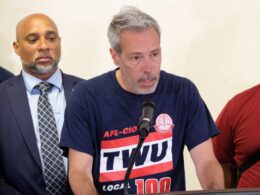A New York judge ruled Wednesday that the Adams administration can resume its plan to remove a protected bike lane from a portion of Bedford Ave. in Brooklyn.
Judge Carolyn Walker-Diallo’s ruling comes just three weeks after she imposed a temporary restraining order — blocking the city’s plans to undo the newly-minted bike lane — in response to a suit filed by a Williamsburg resident last month.
That resident, Baruch Herzfeld, and his minor son joined cycling advocacy group Transportation Alternatives in suing the city after Mayor Adams took to twitter last month to announce his plan to scrap the protected bike lane — which separates bicycle traffic from the rest of the street with a line of parked cars — and move bicycle traffic to the other side of the parking lane, alongside motorized traffic.
In pushing for that arrangement, the Adams administration has cited opposition from some Williamsburg community leaders who say fast moving bikes and e-bikes in the protected lane pose a danger to people crossing mid-block, and children exiting school buses. A video montage released by the mayor’s office shows several children getting hit by e-bikes as they run towards the sidewalk from between parked cars.
One intervenor in the lawsuit, Nathan Schwartz, argued that forcing bicycles to travel alongside cars and trucks would “restor[e] cyclists’ natural instincts for vigilance.”
Another, Samuel Herskovitz, claimed he’d been hit in the hand by a moped traveling at “over 45 MPH” while getting out of a car at a drop-off zone on Bedford Ave.
“I beg the Court, please for my safety and the safety of my children and all the 2,000
children living close to the dangerous new bike lane, please allow the Mayor to shift the bike lane’s location on the roadway,” he said in a court filing.
But those looking to protect the status quo see it differently.
In his suit, Herzfeld alleged “irreparable harm” would come to neighborhood residents if the lane were no longer protected by parked cars, and said the city had failed to give the community proper notice.
Walker-Diallo had initially blocked the city from changing the lane, pending a hearing that had been scheduled for next month. But Walker-Diallo dropped her restraining order on Wednesday, allowing the city to proceed.
“Here, the only change is a modification, where the bike lane orientation is being moved from the interior lane of the street abutting the sidewalk to abutting the traffic lane,” she wrote. “No lanes are being removed.”
“A bike lane will still exist at that location,” she continued. “Therefore the court holds that [the city was] not required to provide prior notice…”
The protected lane was first installed in October 2024. Prior to that, bicycle traffic on Bedford Ave. — a major North-South thoroughfare through central and northern Brooklyn — traveled in a painted lane alongside car and truck traffic.
Testimony filed in the case by the city’s Department of Transportation states that since the opening of the protected bike lane, reported injuries along the relevant section of Bedford Ave. have fallen by 47%.
But the agency admitted that Hatzalah, the private ambulance service that often responds to injuries in the Haredi communities of Williamsburg, does not always report its calls to the city, and as such some pedestrian strikes may not be reflected in the data.








